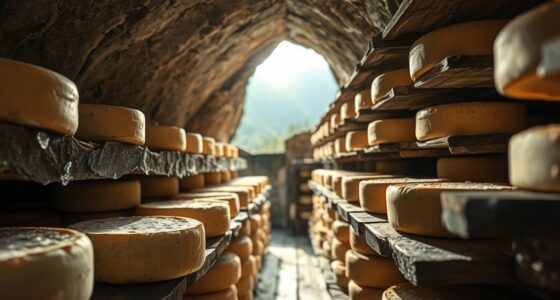Italian coffee culture is a rich blend of history, artistry, and social rituals. It started in the late 19th century with espresso machines, shaping a quick, communal way of sharing coffee. Italians often stand at the bar, enjoying expertly brewed drinks like espresso, cappuccino, and macchiato, with regional twists. Tradition emphasizes quality, etiquette, and ambiance, blending old-world charm with modern trends. Keep exploring to uncover more about Italy’s timeless coffee heritage.
Key Takeaways
- Italian coffee culture emphasizes quick service, standing at the bar, and paying upfront, fostering social interactions and community.
- Traditional brewing methods like espresso machines and moka pots are central to authentic Italian coffee experiences.
- Coffee rituals vary regionally, with northern Italy favoring strong espresso and southern Italy enjoying sweeter, creamier drinks.
- Preservation of historic venues, vintage decor, and serving in characteristic cups uphold Italy’s rich coffee heritage.
- Despite modern trends, Italy maintains a strong emphasis on tradition, craftsmanship, and cultural identity in its coffee practices.
The Origins and Evolution of Italian Coffee Traditions
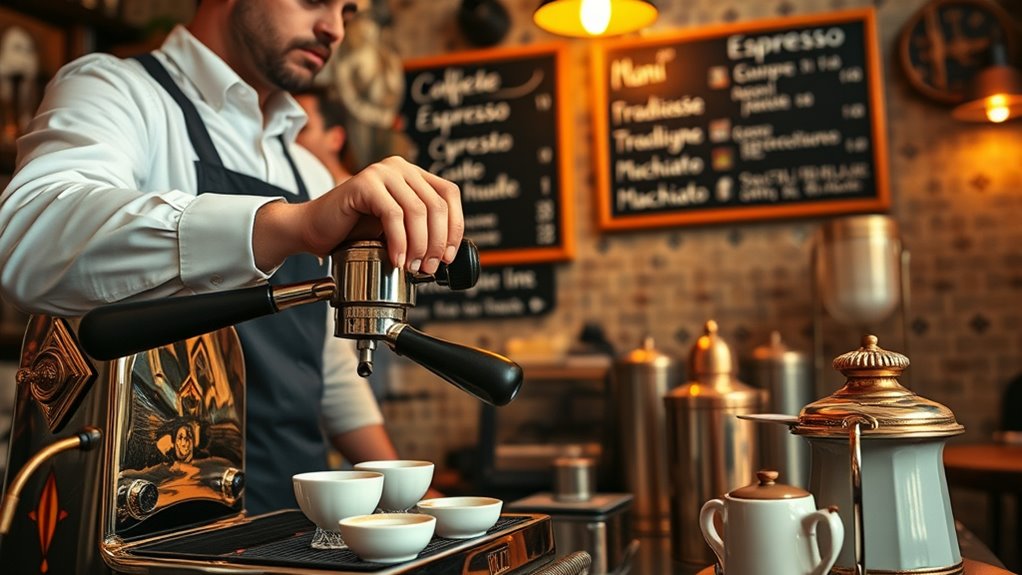
Italian coffee culture has deep roots that date back to the late 19th century, when espresso machines first arrived in the country. From the start, coffee etiquette played a crucial role in social interactions, emphasizing quick, efficient service and a shared appreciation for quality. You’ll notice Italians take bean sourcing seriously, preferring carefully selected beans that meet high standards for freshness and flavor. This focus on sourcing influences the entire tradition, ensuring each cup delivers the authentic taste Italians cherish. Over time, these practices shaped a unique coffee culture rooted in tradition and respect for craftsmanship. Today, the evolution continues, but the core values of proper etiquette and quality bean sourcing remain essential to maintaining Italy’s renowned coffee heritage. Additionally, coffee preparation methods such as the use of a moka pot or espresso machine have become integral to authentic Italian coffee experiences, reflecting a strong emphasis on traditional brewing techniques that have been passed down through generations. These methods are often complemented by a deep appreciation for the social ritual of coffee drinking, which fosters community and shared moments.
The Art of Brewing: Espresso and Beyond

The mastery of brewing methods is at the heart of Italy’s rich coffee culture. You’ll discover that perfect espresso relies on precise brewing techniques, combining finely ground beans, tamping pressure, and water temperature. Beyond espresso, brewing methods like moka pots and Aeropress expand your options, each offering unique flavors and textures. Coffee art plays a key role in elevating your experience, transforming a simple cup into a visual masterpiece. To help you explore, here’s a quick guide:
| Method | Key Feature | Coffee Art Possibilities |
|---|---|---|
| Espresso | Intense, rich flavor | Latte art with steamed milk |
| Moka Pot | Strong, aromatic brew | Foam designs |
| Aeropress | Clean, versatile extraction | Layered or pattern designs |
| French Press | Full-bodied, robust taste | Foam decoration |
| Drip Brew | Mild, consistent flavor | Latte art optional |
Additionally, understanding local resources and tools, such as specialized coffee equipment and skilled baristas, can significantly enhance your brewing experience. Exploring traditional brewing techniques can deepen your appreciation for Italy’s coffee heritage, especially when considering the precision required in each method to achieve optimal results.
Daily Rituals and Social Customs Surrounding Coffee
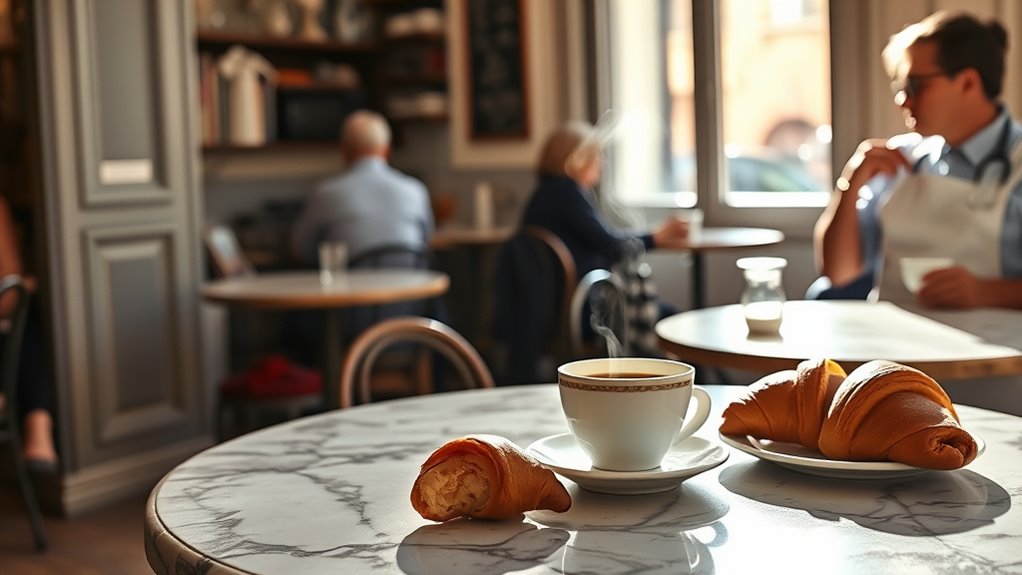
Coffee isn’t just a daily beverage in Italy—it’s a cherished social ritual that brings people together. When you visit a café, you’ll notice strict coffee etiquette; ordering quickly and paying upfront shows respect for others’ time. Italians typically stand at the bar, fostering casual social interactions with baristas and fellow patrons. Slow sipping during conversations emphasizes the importance of connection over speed. Sharing an espresso or macchiato often serves as a break from daily routines, creating moments of camaraderie. Even in busy settings, there’s a sense of ritual and politeness that underscores the social role of coffee. These customs highlight how coffee acts as a daily bond, nurturing relationships and reinforcing community ties through simple yet meaningful interactions. Incorporating mindful creativity strategies into daily routines can also enhance social experiences and personal well-being. Recognizing the cultural significance of coffee in Italy reveals its role beyond mere consumption, emphasizing its importance in fostering social cohesion. Additionally, the traditional customs surrounding coffee consumption help preserve a sense of identity and continuity within Italian society. Acknowledging the creative practice involved in these routines can deepen appreciation and inspire innovative ways to enjoy coffee moments. Understanding the social customs involved in Italian coffee habits can also enrich travelers’ experiences and foster greater appreciation for local traditions.
Regional Variations and Unique Local Practices
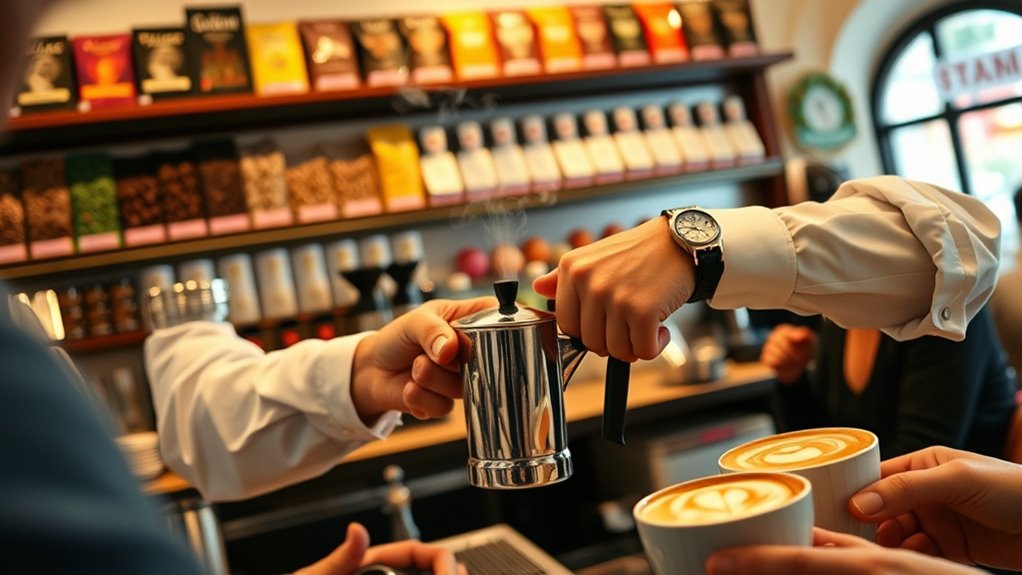
While coffee culture shares common roots across Italy, regional differences add distinct flavors to the experience. In the north, you’ll notice a preference for stronger espresso blends, often enjoyed quickly at local cafes. Moving south, coffee rituals become more relaxed, with some areas emphasizing sweet, creamy drinks like cappuccino, especially in city centers. In Sicily, you might find a love for flavored coffees with local ingredients, reflecting regional flavors. Local customs also shape when and how Italians enjoy their coffee, such as the tradition of drinking espresso standing at the bar or savoring a longer, social pause in smaller towns. These unique local practices highlight the rich diversity within Italy’s coffee scene, making each region’s coffee experience distinctly enthralling. Additionally, the design and ambiance of coffee shops often incorporate farmhouse aesthetics, blending rustic charm with modern comfort to enhance the overall experience and cater to diverse cultural preferences. The integration of regional ingredients further enriches the sensory experience, creating a more authentic and memorable coffee encounter. Furthermore, understanding coffee preparation techniques prevalent in different regions can deepen appreciation for Italy’s diverse coffee traditions.
Modern Trends and How Tradition Continues to Influence Italy’s Coffee Scene
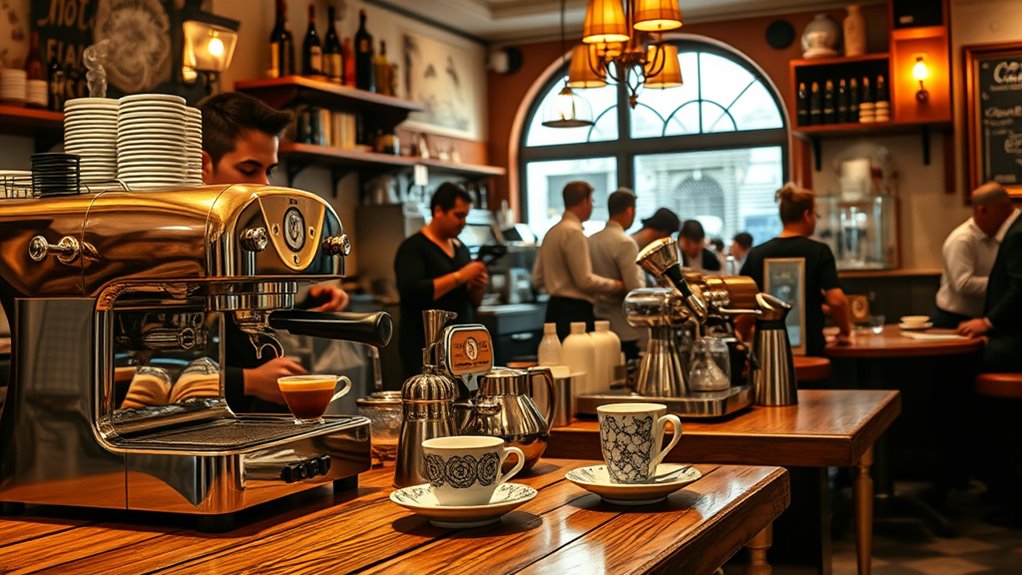
Despite the rapid rise of global coffee chains and modern brewing techniques, Italy’s coffee scene remains deeply rooted in tradition. You still notice coffee etiquette guiding your visit—like never ordering a cappuccino after 11 am. Modern trends blend with classic influences, keeping Italy’s coffee culture vibrant. Many cafes preserve traditional cafe architecture, featuring high ceilings and antique fixtures, which add charm. Some establishments incorporate contemporary designs while respecting heritage. Here’s a quick comparison:
| Traditional Approach | Modern Trends |
|---|---|
| Emphasizes coffee etiquette | Incorporates innovative brewing methods |
| Classic cafe architecture | Fusion of vintage and modern design |
| Focus on espresso culture | Expanded menu with specialty drinks |
This blend of old and new keeps Italy’s coffee scene both authentic and evolving. Recognizing the importance of cultural heritage, many establishments strive to maintain the historical ambiance that defines Italy’s coffee experience.
Frequently Asked Questions
How Do Italians Typically Order Coffee in Cafes?
When you visit an Italian cafe, you usually order your coffee at the counter, often opting for an espresso shot, part of their rich espresso rituals. Italians prefer quick, standing-up coffee sips, appreciating the coffee shop decor that reflects a cozy, authentic atmosphere. You’ll notice that ordering is straightforward—just ask for your espresso, and enjoy the vibrant, community-centered experience that’s a key part of Italian coffee culture.
What Are Some Common Coffee Etiquette Rules in Italy?
When you visit Italy, you’ll want to follow espresso etiquette and respect local coffee social norms. Typically, order your espresso quickly at the bar, avoid drinking cappuccinos after breakfast, and keep your voice low. Don’t linger over your coffee in busy cafes, as Italians value efficiency. Remember, coffee is a quick, social pleasure, so enjoy it with a friendly nod or smile, embracing the authentic Italian coffee experience.
Are There Specific Times When Coffee Is Traditionally Consumed?
They say, “timing is everything,” and in Italy, coffee timing plays a key role in daily routines. You’ll typically enjoy an espresso in the morning or after meals, especially lunchtime and dinner. Italians usually avoid drinking coffee late in the day, as it might disrupt their sleep. So, pay attention to the clock, and you’ll easily fit into their coffee culture, respecting their cherished routines.
How Do Italian Coffee Customs Differ Between Cities and Rural Areas?
You’ll notice that regional variations shape Italian coffee customs between cities and rural areas. In cities like Milan or Rome, coffee culture is lively, with quick espresso shots at cafes. In rural traditions, people often enjoy a more relaxed pace, savoring coffee at home or local taverns. These differences highlight how urban areas embrace a fast-paced coffee scene, while rural areas preserve a slower, more traditional approach to coffee drinking.
What Are Popular Regional Coffee Specialties Across Italy?
Imagine a tapestry of flavors, each region weaving its own coffee story. From Sicily’s strong, sweet granita di caffè to Naples’ intense, velvety espresso, regional coffee variations reflect local traditions. In Venice, you savor a smooth, frothy cappuccino, while in Tuscany, a robust caffè corretto energizes. These special brews, crafted with traditional brewing methods, symbolize Italy’s rich cultural mosaic, inviting you to explore its diverse coffee heritage.
Conclusion
You’ve seen how Italy’s rich coffee traditions blend history, artistry, and social customs. Did you know that Italians consume about 5.5 cups per person daily, reflecting their deep-rooted passion? As modern trends emerge, these traditions still shape every espresso and social moment. Embracing both heritage and innovation, Italy’s coffee scene remains a vibrant affirmation to its cultural identity — a perfect blend of past and present in every sip.


